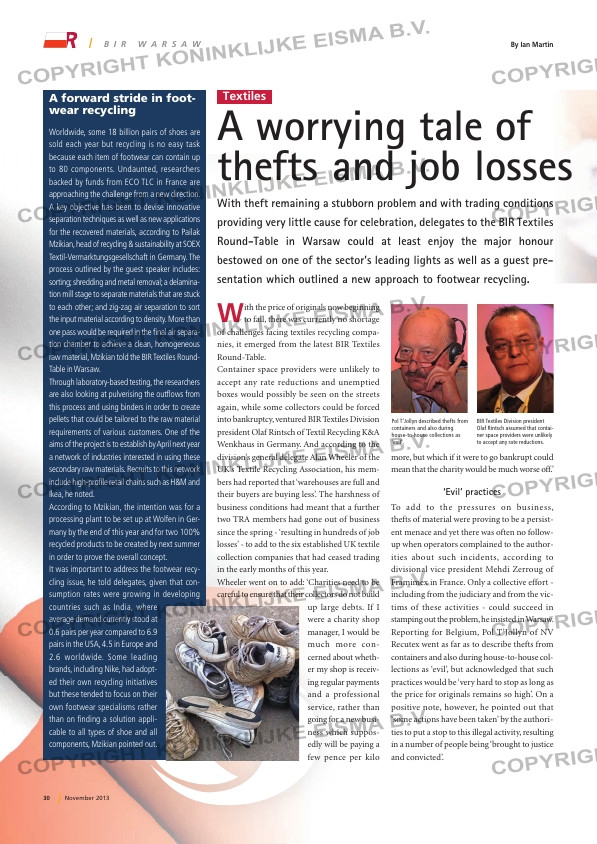Page 30 from: November 2013

30 November 2013
more, but which if it were to go bankrupt could
mean that the charity would be much worse off.’
‘Evil’ practices
To add to the pressures on business,
thefts of material were proving to be a persist-
ent menace and yet there was often no follow-
up when operators complained to the author-
ities about such incidents, according to
divisional vice president Mehdi Zerroug of
Framimex in France. Only a collective effort –
including from the judiciary and from the vic-
tims of these activities – could succeed in
stamping out the problem, he insisted in Warsaw.
Reporting for Belgium, Pol T’Jollyn of NV
Recutex went as far as to describe thefts from
containers and also during house-to-house col-
lections as ‘evil’, but acknowledged that such
practices would be ‘very hard to stop as long as
the price for originals remains so high’. On a
positive note, however, he pointed out that
‘some actions have been taken’ by the authori-
ties to put a stop to this illegal activity, resulting
in a number of people being ‘brought to justice
and convicted’.
B I R W A R S A W By Ian Martin
Pol T’Jollyn described thefts from
containers and also during
house-to-house collections as
‘evil’.
BIR Textiles Division president
Olaf Rintsch assumed that contai-
ner space providers were unlikely
to accept any rate reductions.
With the price of originals now beginning to fall, there was currently no shortage
of challenges facing textiles recycling compa-
nies, it emerged from the latest BIR Textiles
Round-Table.
Container space providers were unlikely to
accept any rate reductions and unemptied
boxes would possibly be seen on the streets
again, while some collectors could be forced
into bankruptcy, ventured BIR Textiles Division
president Olaf Rintsch of Textil Recycling K&A
Wenkhaus in Germany. And according to the
division’s general delegate Alan Wheeler of the
UK’s Textile Recycling Association, his mem-
bers had reported that ‘warehouses are full and
their buyers are buying less’. The harshness of
business conditions had meant that a further
two TRA members had gone out of business
since the spring – ‘resulting in hundreds of job
losses’ – to add to the six established UK textile
collection companies that had ceased trading
in the early months of this year.
Wheeler went on to add: ‘Charities need to be
careful to ensure that their collectors do not build
up large debts. If I
were a charity shop
manager, I would be
much more con-
cerned about wheth-
er my shop is receiv-
ing regular payments
and a professional
service, rather than
going for a new busi-
ness which suppos-
edly will be paying a
few pence per kilo
Worldwide, some 18 billion pairs of shoes are
sold each year but recycling is no easy task
because each item of footwear can contain up
to 80 components. Undaunted, researchers
backed by funds from ECO TLC in France are
approaching the challenge from a new direction.
A key objective has been to devise innovative
separation techniques as well as new applications
for the recovered materials, according to Pailak
Mzikian, head of recycling & sustainability at SOEX
Textil-Vermarktungsgesellschaft in Germany. The
process outlined by the guest speaker includes:
sorting; shredding and metal removal; a delamina-
tion mill stage to separate materials that are stuck
to each other; and zig-zag air separation to sort
the input material according to density. More than
one pass would be required in the fi nal air separa-
tion chamber to achieve a clean, homogeneous
raw material, Mzikian told the BIR Textiles Round-
Table in Warsaw.
Through laboratory-based testing, the researchers
are also looking at pulverising the outfl ows from
this process and using binders in order to create
pellets that could be tailored to the raw material
requirements of various customers. One of the
aims of the project is to establish by April next year
a network of industries interested in using these
secondary raw materials. Recruits to this network
include high-profi le retail chains such as H&M and
Ikea, he noted.
According to Mzikian, the intention was for a
processing plant to be set up at Wolfen in Ger-
many by the end of this year and for two 100%
recycled products to be created by next summer
in order to prove the overall concept.
It was important to address the footwear recy-
cling issue, he told delegates, given that con-
sumption rates were growing in developing
countries such as India, where
average demand currently stood at
0.6 pairs per year compared to 6.9
pairs in the USA, 4.5 in Europe and
2.6 worldwide. Some leading
brands, including Nike, had adopt-
ed their own recycling initiatives
but these tended to focus on their
own footwear specialisms rather
than on fi nding a solution appli-
cable to all types of shoe and all
components, Mzikian pointed out.
With theft remaining a stubborn problem and with trading conditions
providing very little cause for celebration, delegates to the BIR Textiles
Round-Table in Warsaw could at least enjoy the major honour
bestowed on one of the sector’s leading lights as well as a guest pre-
sentation which outlined a new approach to footwear recycling.
A forward stride in foot-
wear recycling
Textiles
A worrying tale of
thefts and job losses
RI-9-BIR Textiles2.indd 30 08-11-13 16:02



